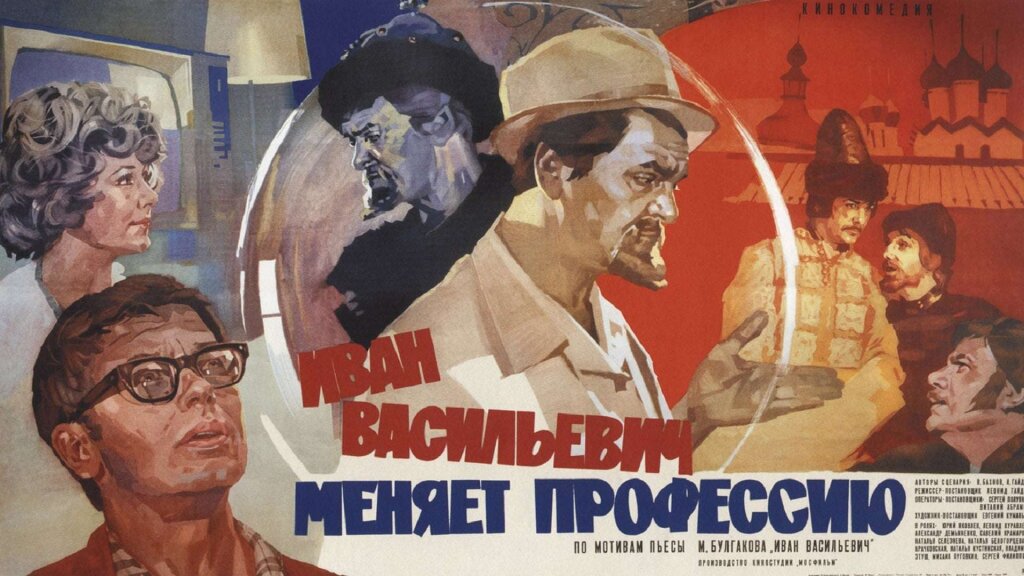Inessa Gelfenboym has a PhD in Comparative Studies in Literature and Culture from the University of Southern California and is currently working on a manuscript titled Utopia after Stalin: Late Soviet Science Fiction and the Re-imagining of Space-time. The following is a condensed version of an article that appeared in the Fall 2018 Issue of the Slavic and East European Journal.
Leonid Gaidai’s now-iconic and beloved comedy Ivan Vasil’evich Changes Profession (1973) was almost too controversial to be produced. The mere idea of reprising Mikhail Bulgakov’s formerly-banned play, Ivan Vasil’evich (written in 1935, published in 1965), was dangerous enough that Yuri Nikulin, a favorite star of Gaidai’s, turned down the title role, assuming that the film would be shelved by censors. Though production was dogged by censorship concerns, the fact that the film was released to widespread acclaim is a testament not only to Gaidai’s humor, but also to his ability to walk a fine line between subversion and support for the Soviet narrative of progress.
Stalin’s campaign of historical revisionism entrenched a narrative of progress, rewriting history to conform to a teleological form, the inevitable endpoint of which was Stalinism itself. The campaign to rehabilitate Ivan the Terrible embodied the Party’s propagation of this narrative. New historical and literary texts portrayed Ivan as having contributed to Russia’s progress toward Socialism and positive, though not overt, comparisons between the tsar and Stalin were drawn throughout.
Bulgakov’s play faced scrutiny and was ultimately banned for creating a narrative in direct opposition to Stalinist teleology, involving Ivan the Terrible no less. Sergei Eisenstein’s Ivan the Terrible Part 2 (completed in 1946, but not released until 1958) encountered trouble for the same reason. Gaidai adapts the former and makes frequent references to the latter. By utilizing these subversive works from the Stalinist past and transposing them into the Soviet 1970s, Gaidai implies parallels between the two periods and emphasizes salutary differences.
Gaidai’s transposition creates a dialogue of different historical emplotments. Hayden White’s Metahistory defines emplotment as the frame that is applied to historical materials in the process of their transformation into narrative form. White describes four emplotments–Romance, Tragedy, Satire and Comedy. I will begin with the first three, as they apply to the narratives of Stalinist teleology, Eisenstein’s film, and Bulgakov’s play respectively, and return to Comedy later.
White defines Romance as “a drama of the triumph of good over evil [...] and of the ultimate transcendence of man over the world in which he was imprisoned by the Fall." Satire is Romance’s opposite. It is “a drama dominated by the apprehension that man is ultimately a captive of the world rather than its master.” Tragedy lies somewhere in between. There is no hope of complete transcendence in a Tragic emplotment and the possibility of partial liberation always comes at a price.
Under Stalin, a successful rehabilitation of Ivan the Terrible was required to be Romantic, implying an optimistic interpretation of history and of Stalin’s political achievements. Where the Party mandated Romance, Eisenstein gave them Tragedy. On the other hand, Bulgakov’s play earned the ire of Soviet critics by presenting a world that remained untouched by progress, thereby portraying history as Satire.
Gaidai adapted Bulgakov’s play, an already risky procedure, and built into this adaptation references to Eisenstein’s film—the tsar’s costume and the dance of the oprichniks. Gaidai’s interpretation unfettered these unacceptable depictions of Ivan the Terrible. He confronted the audience not only with the fact of historical revisionism, but also with what these intolerable Ivans implied about Soviet society and Russian history. Gaidai’s film undermines teleology on two fronts: it confronts Stalinism with its own flotsam, the subversive narratives that resurfaced once Stalinism itself was being repressed; and it reveals how Stalinism lingered over the late Soviet period.
The distended and overreaching bureaucracy, which emerged under Stalin and grew under Brezhnev, was, for most viewers, the most familiar “ghost” of the Stalinist past. House Manager Bunsha was its representative. His status as a remnant of Stalinism is affirmed by his resemblance to Ivan the Terrible, who acts as Stalin’s proxy. The uncanny physical resemblance between the house manager and the tsar is revealed to be an essential kinship when even Bunsha dresses and begins to easily act the part of tsar during his royal banquet. As the bureaucrat and the autocrat are rendered interchangeable, so too are the epochs from which they hail.
Though the film draws dangerous parallels, its widespread release and popular reception is a testament to Gaidai’s evocation of a historical form that neither submits to nor endangers Soviet teleology. The film curates an amalgam of references from the past and makes them present, molding them into a system geared toward laying bare the manifold devices of Stalinism, exposing its continued presence, and rendering it harmless in order to move beyond it.
Though he creates and sometimes foregrounds links between the present day and the not-so-distant Stalinist past, the transposition of the narrative from past to present also serves to counter the Stalinist element, neutralizing the threat it poses to the film’s protagonist. The film proposes a shape for historiographical movement that runs counter to both the linear movement of Stalinist teleology and the purely cyclical movement of Bulgakov’s Satire, undermining the future utopia supposedly guaranteed by progress, but intimating the possibility of futures independent of history’s cycles.
Gaidai’s adaptation was indeed a change of profession for the play; though it was written as a Satire, it is recast in the mode of Comedy. Comedy, the obverse of Tragedy, lies, like its counterpart, between Romance and Satire: “In Comedy, hope is held out for the temporary triumph of man over his world by the prospect of occasional reconciliations of the forces at play in the social and natural worlds,” as White wrote.
Gaidai invokes Stalinism in order to diffuse it by means of its own devices. Stalin’s terror is often described as a manifestation of the carnivalesque. In order to overcome its trauma, Gaidai’s humor subjects the terror itself to the power of carnivalesque reversal: the oprichniks are felled by a man inside a suit of armor; and Ivan the Terrible is deprived of his royal garb, arrested, and nearly institutionalized. Carnivalizing the terror becomes an act of mourning — the film portrays terror in order to mock it, and to create distance from it.
Though the film rejects Stalin’s heavily doctored history and its accompanying linear temporality, it refuses to embrace fully the infinite loop of history implied by Bulgakov’s play. Gaidai’s system of references engenders a world of entrenched power structures, of historical narratives that emerge in different guises but are otherwise indistinguishable from their predecessors. However, because it is Comedy, not Satire, ephemeral reconciliation between individual and world is how Gaidai closes his film.
Gaidai’s means of reconciliation is the private sphere. Both history and time lose their universal quality and become personal–dividing society, but protecting its denizens from the destructive generalization of universal temporality. Mass utopia is replaced by the utopian enclave. The individual is not swept up in the overarching movement of history toward the inevitable future, nor is he trapped by the eternal recurrence of history; he resides in a private universe where utopia exists on the level of the quotidian, where individual decisions and actions create the future rather than merely correspond to it.
Timofeev’s apartment is a zone of private temporality and a sanctuary from the dangers of Soviet society and Russian history. Just as the apartment is protected from the hazards of the outside world, the outside world is protected from the alternative temporality of Timofeev’s apartment. Though they undermine one another, each is able to tolerate the other so long they remain apart.
Soviet citizens are also adept at functioning beyond the borders of the private sphere. Ivan the Terrible’s palace is the space of the most immediate danger, a highly politicized arena where Ivan’s agents threaten the safety of Bunsha and Miloslavskii. However, in spite of Ivan’s confidence that the pair will be beheaded, they survive by adapting to the environment.
By hiding in one’s place of refuge or by means of camouflage, characters move tentatively into the future by living in the present. It is in these pockets of freedom that man is able to be reconciled to the world.
Though it subverts Stalinist teleology, this alternative temporality is also limiting. With the possibility of mass utopia growing ever more distant, the film does not topple the dominant temporal schematization, but avoids it. Timofeev’s apartment has its own independent temporality. Though the borders of this space are porous, neither inside nor outside has any interest in interpenetration.
There is a sense that this solution is not all together satisfying. The lyrics of Vladimir Vysotskii’s song, to which Ivan the Terrible weeps bitterly, gesture toward this limitation. Based on an 1857 poem, the song weaves together several narratives of lost love and ties them together with a refrain (“Oh, once, again, and once again/ and many, many, many times”). The refrain’s emphasis on recurrence indicates that the narrative threads of the song have recurred since the nineteenth century and will continue to recur. Private space, as it happens, is also a space of recurrence. Though retreat into private temporality enables an active engagement with the present, it sacrifices the future for the sake of that present.



